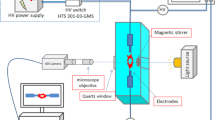Abstract
Hydrogen peroxide production by an AC driven capillary underwater discharge was investigated quantitatively. Concentration of formed hydrogen peroxide was measured by a colorimetric method using a specific reaction between H2O2 and a titanium reagent. It comes out that the amount of H2O2 increases linearly during the first hour of the discharge duration and is slightly higher at the high voltage side of the capillary. The initial rate of H2O2 formation by the capillary discharge was therefore determined for initial electrical conductivity of aqueous solution in the range of 100 ÷ 500 µS cm−1. The initial rate of H2O2 formation increases with applied power at fixed initial conductivity of aqueous solution. Experiments performed at fixed applied power indicate that the initial conductivity appears to have only negligible effect on the initial rate of H2O2 formation.
Similar content being viewed by others
References
J. S. Clements, M. Sato and R. H. Davis: IEEE Trans. Ind. Appl. IA-23 (1987) 224.
B. Sun, M. Sato and J. S. Clements: J. Electrost. 39 (1997) 189.
A. A. Joshi et al.: Journal of Hazardous Materials 41 (1995) 3.
W. F. L. M. Hoeben et al.: J. Phys. D: Appl. Phys. 32 (1999) L133.
P. Šunka et al.: Plasma Sources Sci. Technol. 8 (1999) 258.
P. Šunka: Physics of Plasmas 8(5) (2001) 2587.
B. R. Locke et al.: Ind. Eng. Chem. Res. 45 (2006) 882.
F. De Baerdemaeker, M. Monte and C. Leys: Czech. J. Phys. 54 Suppl. C (2004) 1062.
F. De Baerdemaeker, C. Leys and M. Šimek: Proc. 17 th ISPC, Toronto, Canada (7–12 August 2005).
E. M. Drobyshevskii, Yu. A. Dunaev and S. I. Rozov: Sov. Phys. Tech. Phys. 18(6) (1973) 772 [Zh. Tekh. Fiz. 43(6) (1973) 1217 (in Russian)].
I. P. Kuzhekin: Proc. 9 th Int. Symp. on High Voltage Engineering, Graz, Austria (28 August–1 September 1995) 8073–1.
M. Sato, Y. Yamada and B. Sun: Inst. Phys. Conf. Ser. 163 (1999) 37.
M. Monte et al.: Czech. J. Phys. 52 Suppl. D (2002) 724.
G. M. Eisenberg: Ind. Eng. Chem. Anal. Ed. 15(5) (1943) 327.
P. Lukeš: Water treatment by pulsed streamer corona discharge, Ph.D. Dissertation, Institute of Chemical Technology, Prague, Czech Republic, 2001.
Z. Stará and F. Krčma: Czech. J. Phys. 54 Suppl. C (2004) 1050.
Z. Stará, F. Krčma and P. Slavíček: Proc. 17 th ISPC, Toronto, Canada (7–12 August 2005).
P. Šunka et al.: Acta Phys. Slovaca 54(2) (2004) 135.
Author information
Authors and Affiliations
Rights and permissions
About this article
Cite this article
De Baerdemaeker, F., Šimek, M., Člupek, M. et al. Hydrogen peroxide production in capillary underwater discharges. Czech J Phys 56 (Suppl 2), B1132–B1139 (2006). https://doi.org/10.1007/s10582-006-0339-4
Received:
Issue Date:
DOI: https://doi.org/10.1007/s10582-006-0339-4




